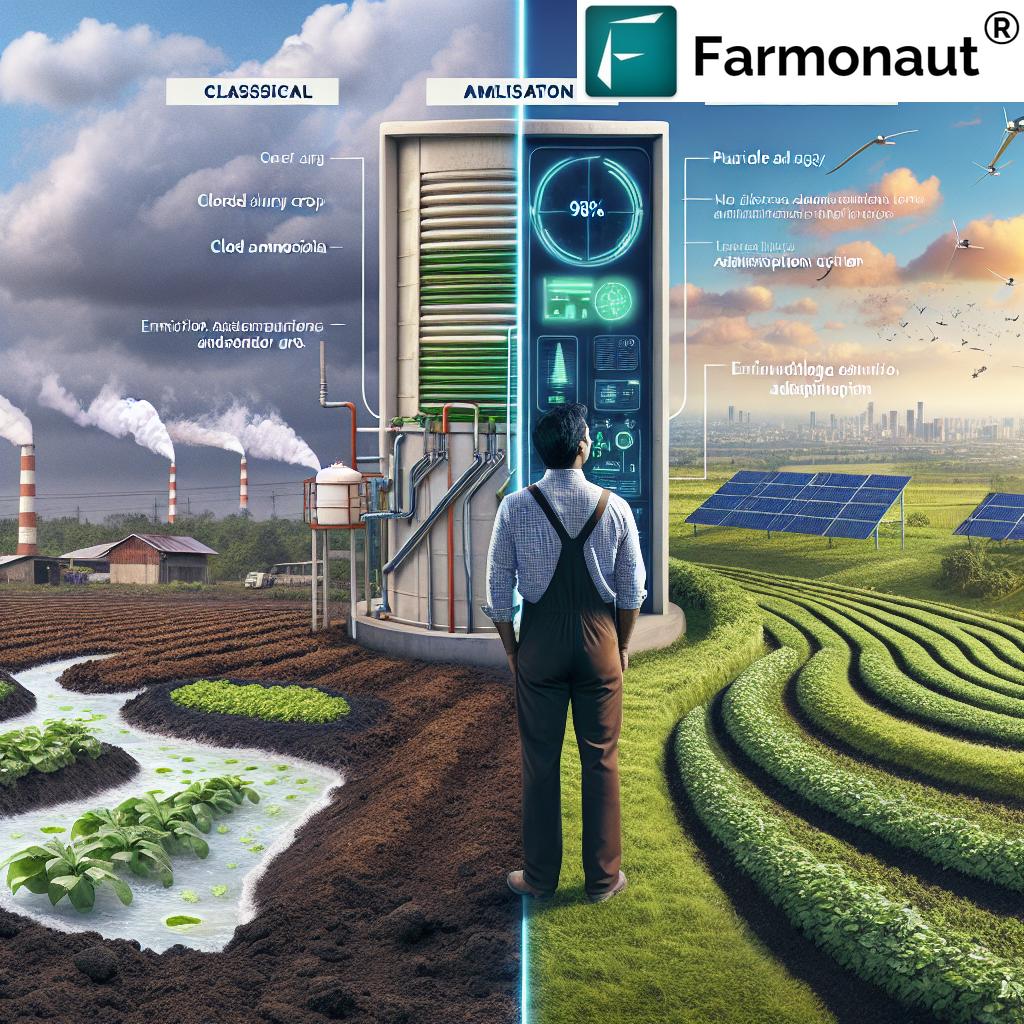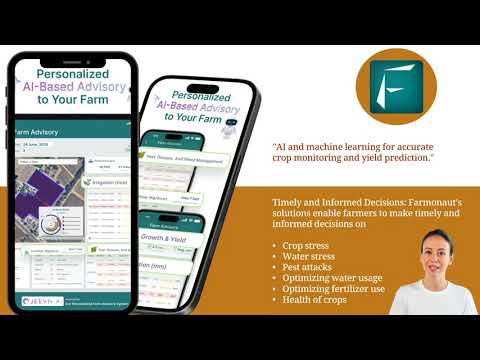Revolutionary Slurry Management: UK Farm’s Sustainable Tech Slashes Emissions and Boosts Crop Yields
“UK farm’s solar-powered slurry tech reduces ammonia and methane emissions by 98%, revolutionizing sustainable agriculture.”
In the ever-evolving landscape of agriculture, we are witnessing a remarkable transformation in the way farms manage their resources and impact on the environment. At the forefront of this revolution is a groundbreaking innovation in slurry management that has emerged from a UK farm. This cutting-edge technology not only addresses the pressing issue of agricultural emissions but also promises to reshape the future of sustainable farming practices.
As we delve into the details of this revolutionary slurry management system, we’ll explore how it’s setting new standards for environmental stewardship in agriculture while simultaneously boosting crop yields. This blog post will provide a comprehensive look at the technology, its implications for the farming industry, and how it fits into the broader context of sustainable agriculture.
Understanding the Challenge: Slurry Management in Modern Agriculture
Before we dive into the innovative solution, it’s crucial to understand the challenge that slurry management poses in modern agriculture. Slurry, a mixture of animal manure and water, is a byproduct of livestock farming that has long been both a valuable resource and a significant environmental concern.
- Nutrient-rich resource: Slurry contains essential nutrients for crop growth, making it a valuable fertilizer.
- Environmental impact: Traditional slurry management methods often lead to high ammonia and methane emissions, contributing to air pollution and climate change.
- Odor issues: Improper slurry management can result in unpleasant odors, affecting local communities.
- Water pollution risks: Runoff from poorly managed slurry can contaminate water sources, harming aquatic ecosystems.
These challenges have long been a thorn in the side of farmers and environmental regulators alike. The need for a solution that balances the nutritional benefits of slurry with environmental responsibility has never been more pressing.
The Solar-Powered Revolution in Slurry Management
“Innovative manure treatment boosts crop yields by 36%, offering a solution to rising fertilizer costs and environmental concerns.”
Enter the game-changing technology developed on a UK farm. This innovative system harnesses the power of the sun to transform livestock manure into an environmentally friendly fertilizer, achieving remarkable results in emission reduction and crop yield improvement.
Key Features of the New Technology:
- Solar-powered operation: Utilizing renewable energy, reducing the carbon footprint of the process.
- Electrical current application: A carefully controlled electrical current is applied to the manure, altering its chemical composition.
- Emission reduction: The process achieves a staggering 98% reduction in ammonia and methane emissions.
- Yield improvement: Crops fertilized with the treated slurry show a 36% increase in yield.
- Cost-effective: Offers a potential solution to rising fertilizer costs.
This revolutionary approach aligns perfectly with the principles of precision agriculture, offering farmers a way to maximize the benefits of their resources while minimizing environmental impact.

The Science Behind the Innovation
To truly appreciate the significance of this technological breakthrough, it’s essential to understand the science that underpins it. The process involves several key steps:
- Collection: Raw slurry is collected from livestock housing and stored in a central tank.
- Pre-treatment: The slurry undergoes initial processing to remove solid materials and ensure a consistent liquid composition.
- Electrolysis: Solar-powered electrodes apply a carefully controlled electrical current to the slurry.
- Chemical transformation: The electrical current triggers chemical reactions that break down ammonia and methane compounds.
- Nutrient preservation: While harmful emissions are reduced, beneficial nutrients are retained and even enhanced.
- Storage and application: The treated slurry is stored for later use as a high-quality, environmentally friendly fertilizer.
This process represents a significant leap forward in manure management techniques, addressing multiple challenges simultaneously.
Environmental Benefits and Agricultural Impact
The implementation of this innovative slurry management system brings a host of benefits to both the environment and agricultural productivity:
Environmental Benefits:
- Reduced greenhouse gas emissions: The 98% reduction in ammonia and methane emissions significantly lowers the farm’s carbon footprint.
- Improved air quality: Lower ammonia emissions lead to better air quality in and around the farm.
- Water protection: The treated slurry is less likely to cause water pollution if accidentally released into the environment.
- Odor reduction: The treatment process significantly reduces the characteristic odor associated with manure, benefiting local communities.
Agricultural Impact:
- Enhanced crop yields: The 36% increase in crop yields translates to improved farm productivity and profitability.
- Cost savings: By reducing the need for synthetic fertilizers, farmers can save on input costs.
- Soil health improvement: The treated slurry contributes to better soil structure and microbial activity.
- Compliance with regulations: The technology helps farmers meet increasingly stringent environmental regulations.
These combined benefits demonstrate how sustainable agriculture technology can create a win-win situation for farmers and the environment.
The “Transition” Initiative: A Catalyst for Change
This revolutionary slurry management technology is part of a broader movement known as the “Transition” initiative. This program aims to accelerate the adoption of sustainable farming practices and technologies across the UK and beyond.
Key Aspects of the Transition Initiative:
- Research and development: Funding and support for innovative agricultural technologies.
- Knowledge sharing: Creating platforms for farmers to exchange experiences and best practices.
- Policy support: Working with government bodies to create favorable policies for sustainable farming.
- Financial incentives: Providing grants and subsidies to help farmers adopt new technologies.
- Education and training: Offering workshops and courses on sustainable agriculture techniques.
The success of the slurry management technology serves as a shining example of what can be achieved through the Transition initiative, inspiring further innovations in the field.
Comparison: Traditional vs. New Slurry Management Technology
| Aspect | Traditional Method | New Solar-Powered Technology |
|---|---|---|
| Ammonia Emission Reduction | 0-10% | 98% |
| Methane Emission Reduction | 0-5% | 98% |
| Crop Yield Increase | 0-5% | 36% |
| Energy Source | Fossil Fuels | Solar Power |
| Environmental Impact | High | Low |
| Initial Investment Cost | Low | High |
| Long-term Cost Savings | Low | High |
This comparison clearly illustrates the significant advantages of the new technology over traditional methods, particularly in terms of environmental impact and agricultural productivity.
Implications for UK Food Security and Beyond
The success of this slurry management technology has far-reaching implications for UK food security and the global agricultural landscape:
- Increased domestic food production: Higher crop yields contribute to greater food self-sufficiency.
- Reduced reliance on imports: As local production increases, dependency on imported fertilizers and food may decrease.
- Export potential: The technology itself could become a valuable export, boosting the UK’s agricultural technology sector.
- Climate change mitigation: Reduced emissions from agriculture contribute to national and global climate goals.
- Biodiversity protection: Lower pollution levels help preserve local ecosystems and biodiversity.
These outcomes align with broader goals of sustainable development and food security, positioning the UK as a leader in agricultural innovation.

The Role of Precision Agriculture in Modern Farming
The revolutionary slurry management technology is just one example of how precision agriculture is transforming the farming industry. Precision agriculture encompasses a range of technologies and practices that allow farmers to optimize their operations for maximum efficiency and sustainability.
Key Components of Precision Agriculture:
- Satellite imagery and remote sensing: Used for crop monitoring and field mapping.
- GPS-guided machinery: Enables precise application of inputs and reduces overlap.
- Soil sensors: Provide real-time data on soil moisture and nutrient levels.
- Weather stations: Offer localized weather data for informed decision-making.
- Data analytics: Help farmers interpret complex data sets for better management decisions.
These technologies work together to create a more efficient and environmentally friendly farming system. At Farmonaut, we recognize the importance of such innovations in shaping the future of agriculture. Our satellite-based farm management solutions complement these advancements, providing farmers with valuable insights for optimal crop management.
You can explore our services through our  or by downloading our mobile apps:
or by downloading our mobile apps:
Challenges and Future Developments
While the new slurry management technology represents a significant breakthrough, there are still challenges to overcome and opportunities for further development:
Current Challenges:
- High initial costs: The technology requires substantial upfront investment, which may be prohibitive for some farmers.
- Technical expertise: Operating and maintaining the system requires specialized knowledge.
- Scalability: Adapting the technology for farms of different sizes and types presents logistical challenges.
- Regulatory alignment: Ensuring the technology meets evolving environmental regulations across different regions.
Future Developments:
- Cost reduction: Ongoing research aims to make the technology more affordable for wider adoption.
- Integration with other systems: Combining slurry management with other precision agriculture technologies for holistic farm management.
- Artificial intelligence: Incorporating AI for optimized operation and predictive maintenance.
- Biogas production: Exploring ways to capture and utilize methane for on-farm energy generation.
These challenges and potential developments highlight the dynamic nature of agricultural technology and the ongoing efforts to improve sustainability in farming.
The Broader Impact on Sustainable Agriculture
The success of this slurry management technology has implications that extend far beyond individual farms. It represents a significant step forward in the broader movement towards sustainable agriculture:
- Circular economy in agriculture: By transforming waste into a valuable resource, the technology exemplifies circular economy principles.
- Reduced chemical dependency: The improved efficacy of organic fertilizers could lead to reduced reliance on synthetic chemicals.
- Climate-smart agriculture: This innovation contributes to climate change mitigation efforts in the agricultural sector.
- Improved rural livelihoods: Increased farm productivity and reduced input costs can enhance the economic viability of rural communities.
- Consumer awareness: Innovations like this raise public awareness about sustainable farming practices and their importance.
These broader impacts underscore the potential of technology to drive positive change in the agricultural sector and beyond.
The Role of Policy and Incentives
For innovations like this slurry management technology to achieve widespread adoption, supportive policies and incentives are crucial. Governments and agricultural organizations play a vital role in creating an environment that encourages sustainable practices:
Policy Measures:
- Environmental regulations: Setting and enforcing emission standards for agricultural operations.
- Research funding: Allocating resources for the development of sustainable agricultural technologies.
- Tax incentives: Offering tax breaks or credits for farms that adopt environmentally friendly practices.
- Carbon pricing: Implementing carbon pricing mechanisms that reward emission reductions in agriculture.
Incentive Programs:
- Grants and subsidies: Providing financial support for farmers to invest in new technologies.
- Knowledge transfer programs: Facilitating the sharing of best practices and technical know-how.
- Certification schemes: Developing eco-labels or certifications that recognize sustainable farming practices.
- Market access support: Helping farmers access premium markets for sustainably produced goods.
These policy and incentive measures can create a supportive ecosystem for the adoption of innovative technologies like the solar-powered slurry management system.
The Global Perspective: Lessons for International Agriculture
While this technology has been developed and implemented in the UK, its principles and benefits have global relevance. As we face worldwide challenges in food security and environmental sustainability, innovations like this offer valuable lessons:
- Adaptability: The core principles of the technology can be adapted to different agricultural contexts worldwide.
- Technology transfer: Sharing knowledge and expertise can help accelerate sustainable agriculture adoption globally.
- International collaboration: Cross-border research initiatives can lead to breakthroughs applicable to diverse farming systems.
- Addressing global challenges: Such innovations contribute to global efforts in climate change mitigation and sustainable development.
The success of this UK farm’s slurry management system serves as an inspiration and a model for sustainable agriculture initiatives around the world.
The Future of Farming: Integration and Innovation
As we look to the future of agriculture, it’s clear that innovations like the solar-powered slurry management system are just the beginning. The future of farming will likely be characterized by increased integration of various technologies and practices:
- Internet of Things (IoT) in agriculture: Interconnected sensors and devices for comprehensive farm monitoring.
- Robotics and automation: Advanced machinery for precision planting, harvesting, and livestock management.
- Vertical and urban farming: Innovative growing systems to maximize space and bring food production closer to urban centers.
- Genetic engineering and CRISPR technology: Developing crop varieties resistant to pests, diseases, and climate change impacts.
- Big data and predictive analytics: Leveraging vast amounts of data for more accurate farming decisions and risk management.
These advancements, combined with sustainable practices like improved slurry management, will shape the farms of the future. At Farmonaut, we’re committed to being at the forefront of these developments, offering cutting-edge satellite-based solutions to support farmers in this evolving landscape.
For developers interested in integrating our technology into their own agricultural solutions, we offer a robust API. Detailed documentation is available in our API Developer Docs.
Conclusion: A New Era in Sustainable Agriculture
The revolutionary slurry management technology developed on a UK farm marks a significant milestone in the journey towards sustainable agriculture. By dramatically reducing emissions, improving crop yields, and offering a solution to rising fertilizer costs, this innovation demonstrates the power of technology to address some of the most pressing challenges in modern farming.
As we’ve explored throughout this article, the implications of this breakthrough extend far beyond a single farm or even the UK agricultural sector. It represents a model for how innovative thinking, combined with supportive policies and incentives, can drive meaningful change in the way we produce food and manage our natural resources.
The success of this technology serves as an inspiration for farmers, researchers, and policymakers worldwide. It shows that with the right approach, we can achieve the seemingly contradictory goals of increasing agricultural productivity while reducing environmental impact.
As we look to the future, it’s clear that sustainable agriculture technology will play an increasingly crucial role in ensuring food security, protecting our environment, and supporting rural economies. Innovations like this slurry management system, along with other precision agriculture technologies, are paving the way for a more sustainable and productive agricultural sector.
At Farmonaut, we’re proud to be part of this agricultural revolution, providing farmers with the tools and insights they need to embrace sustainable practices and thrive in an ever-changing world. Together, we can build a future where agriculture not only feeds the world but also helps to heal it.
FAQs
- Q: How does the solar-powered slurry management technology work?
A: The technology applies an electrical current to livestock manure using solar power. This process alters the chemical composition of the slurry, reducing harmful emissions while preserving beneficial nutrients. - Q: What are the main benefits of this new slurry management system?
A: The key benefits include a 98% reduction in ammonia and methane emissions, a 36% increase in crop yields, and potential cost savings on fertilizer. - Q: Is this technology suitable for all types of farms?
A: While the technology has shown great success, its suitability may vary depending on farm size, type of livestock, and local conditions. Further research is ongoing to adapt the system for different agricultural contexts. - Q: How does this innovation contribute to sustainable agriculture?
A: By reducing emissions and improving fertilizer efficiency, this technology helps minimize agriculture’s environmental impact while enhancing productivity, aligning with sustainable agriculture principles. - Q: What role do government policies play in the adoption of such technologies?
A: Government policies are crucial in providing financial incentives, research funding, and regulatory frameworks that encourage the adoption of sustainable agricultural technologies like this slurry management system.


















